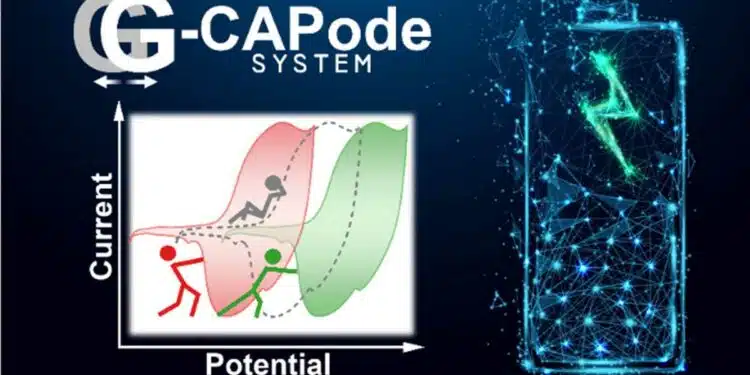Researchers from TU Dresden, Germany demonstrated a gated highly variable pseudocapacitor (supercapacitor) based on redox-window control (G-CAPode). The article was recently published in Energy Storage Materials Journal.
Researchers are proposing a novel iontronic device offering flexible control of the current output of a switchable electrochemical capacitor diode (CAPode) by introducing an additional “gate” electrode. This device mimics field-effect transistor (FET) semiconductors in controlling current output and recovers energy consumed during the forward charging, marking a significant breakthrough.
A recently developed unidirectional CAPode system (Ni3Bi2S2@Ni I 1 mol L-1 KOH I AC@Ni) serves as the “working” capacitor (W-Cap) in the novel architecture. The proposed G-CAPode (gate-controlled CAPode) features a third voltage-controlled connection between the “gate” and the counter electrode of the W-Cap.
By varying this third voltage channel the electrodes of W-Cap are shifted in potential toward negative or positive potential windows. Hence, by external voltage control the rectification ratios and blocking efficacy can be tuned which is essential for fully controlling the output signal in logic gates. A new circuit monitors the current and potential distribution of the NOT gate: The G-CAPode system exhibits transistor-like characteristics with a −1.2 V bias. This investigation highlights the versatility of the G-CAPode system across applications where transistor-like behavior and accurate current regulation are beneficial, promising advancements in ionologic devices, sensors, and energy storage systems.
The device proposed here is the first of its kind, in which the electrochemical response of a switchable electrochemical capacitor diode (CAPode) is deliberately controlled over several orders of magnitude by introducing a third “gate” electrode (GE) into this system.
By applying an appropriate bias potential to the GE, it is possible to control the rectification ratios and capacitance, a novel feature as compared to earlier CAPodes developed. In essence, the new system represents truly a variable capacitor. The analysis of the mechanism of the G-CAPode operation (constructed here based on the ion-selective redox surface effect in Ni3Bi2S2@Ni I 1 mol L-1 KOH I AC@Ni CAPode) provides a rational basis for an entire platform of future controllable ionotronic devices, a new family of variable capacitors based on deliberate potential window control of pseudocapacitive systems.
Considering the rich redox chemistry in aqueous and non-aqueous systems as well as the enormous number of publications on pseudocapacitors, the new G-CAPode architecture may be rapidly expandable into a generic platform of switchable PCs offering a wide range of operational windows for various applications.
Variable capacitors are an essential element in adiabatic computing with reduced energy consumption. Furthermore, they are used in filters and oscillators. A proof-of-concept NOT gate provided effective operation based on the novel G-CAPode performance and in depth understanding by monitoring the current and potential distribution.
The G-CAPode system exhibits transistor-like behavior under certain bias conditions determined by the potential matching of WE and GR at a specific bias voltage. Variations in bias voltage leads to significant amplification and variation of the current response over more than three orders of magnitude by manipulating the electrode potentials and extent of redox reactions and current flow.
Overall, the study highlights the potential of the G-CAPode system for various applications where transistor-like behavior and precise control of current flow are desirable. Further research in this area could lead to advancements in electronic devices, wearables, sensors, and power regulation of energy storage systems. The proof-of-concept applications of such variable ultracapacitor systems in logic circuits, signal switching and current amplification is promising. Further research may reveal the wide applicability of the G-CAPode concept and demonstration of scalability.
Link to the original scientific article:
Ahmed Bahrawy, Przemyslaw Galek, Christin Gellrich, Nick Niese, Julia Grothe, Stefan Kaskel, “A gated highly variable pseudocapacitor based on redox-window control (G-CAPode)”, Energy Storage Materials, Volume 74, 2025, 103872, ISSN 2405-8297,
https://doi.org/10.1016/j.ensm.2024.103872































